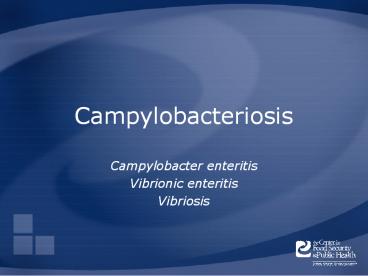Campylobacteriosis - PowerPoint PPT Presentation
Title:
Campylobacteriosis
Description:
Campylobacteriosis Campylobacter enteritis Vibrionic enteritis Vibriosis Campylobacter fetus subsp. fetus is transmitted by ingestion in cattle, sheep and goats. – PowerPoint PPT presentation
Number of Views:2079
Avg rating:3.0/5.0
Title: Campylobacteriosis
1
Campylobacteriosis
- Campylobacter enteritis
- Vibrionic enteritis
- Vibriosis
2
Overview
- Organism
- History
- Epidemiology
- Transmission
- Disease in Humans
- Disease in Animals
- Prevention and Control
- Actions to Take
3
The Organism
4
The Organism
- Family Campylobacteriaceae
- Gram negative, microaerophilic
- Curved or spiral rods
- Causes of enteritis
- Campylobacter jejuni
- Campylobacter coli
- Causes of infertility and abortion
- C. jejuni
- C. fetus subsp. venerealis
- C. fetus subsp. fetus
5
The Organism
- Survives in moist environments
- Weeks to months
- Some strains tolerate cold
- Remains viable in
- Feces
- Milk
- Water
- Vaginal discharges
- Poultry litter
6
History
7
History
- 1886
- Spiral bacteria first
described - 1968
- Campylobacter isolatedfrom human feces
- 1970s
- Recognized as human pathogen
8
Epidemiology
9
Morbidity and Mortality Humans
- Common cause of bacterial diarrhea in the U.S.
- 20 cases/100,000 people annually
- Causes 5 to 14 of diarrhea worldwide
- Populations at risk
- Young children
- People in developing countries
- Immunosuppressed
10
Morbidity and Mortality Humans
- Top five pathogens contributing to domestically
acquired foodborne illness (U.S.) in 2011 - Norovirus
- Salmonella (non-typhoidal)
- Clostridium perfringens
- Campylobacter spp.
- 845,024 estimated illnesses
- Staphylococcus aureus
11
Morbidity and Mortality Animals
- Asymptomatic carriage more common than enteric
disease - Up to 45 of cats, 75 of dogs
- Higher in animal shelters, pet shops, strays,
rural animals - High incidence in poultry
- Abortion in sheep
- 10 to 20 abortion rate
- Mortality low for all causes
12
Transmission
13
Transmission C. jejuni
- Fecal-oral
- Direct contact
- Fomites
- Bacteria found in/on
- Vaginal discharges, abortion products
- Undercooked meat, raw milk
- Mechanical vector
- Common housefly
14
Transmission C. fetus subsp. fetus
- Ingestion
- Contact with
- Feces, vaginal discharges,
aborted fetuses, fetal membranes - Venereal (cattle)
- Fomites
- Semen, instruments, bedding
- Cattle may become carriers
15
Disease in Humans
16
Disease in Humans
- Nearly all cases due to C. jejuni
- Enteritis
- Mild to fulminant or relapsing colitis
- Diarrhea (may contain blood)
- Fever, nausea, vomiting
- Abdominal pain
- Complications uncommon
- Guillain-Barré syndrome
17
Disease in Humans
- C. fetus
- Opportunistic human pathogen
- Causes systemic
infections - Immunocompromised
persons at risk
- Potential Complications
- Endocarditis
- Pericarditis
- Pneumonia
- Thrombophlebitis
- Peritonitis
- Meningoencephalitis
18
Diagnosis
- Presumptive diagnosis
- Microscopy
- Characteristic darting motility
- Curved or spiral rods
- Definitive diagnosis
- Fecal or (rarely) blood cultures
- Organism may be difficult to isolate
- Biochemical, antigen testing
- PCR, ELISA
19
Treatment
- Supportive care
- Fluid and electrolyte therapy
- Antibiotics
- Efficacy not proven for mild infections
- May reduce shedding
- Complications
- Guillain-Barré syndrome
- Requires intensive care
20
Disease in Animals
21
Species Affected
- Cattle, sheep
- Chickens
- Turkeys
- Dogs, cats
- Mink, ferrets
- Pigs
- Non-human primates
22
Disease in Animals
- Enteritis
- Many species affected
- Young animals
- Diseased or stressed adults
- Usually resolves in 3 to 7 days
- Intermittent diarrhea may persist
- Newly hatched chicks and poults
- Acute disease and death
23
Disease in Animals
- Reproductive disease
- Bovine genital campylobacteriosis
- Infertility
- Early embryonic death
- Abortion uncommon
- Campylobacteriosis in sheep
- Late term abortion
- Weak lambs
- Metritis
- Death
24
Disease in Animals
- Other Campylobacter spp. may cause disease in
animals - Species
- C. lari
- C. hyointestinalis
- C. upsaliensis
- Disease
- Proliferative ileitis of hamsters
- Porcine proliferative enteritis
- Proliferative colitis of ferrets
25
Post Mortem Lesions
- Congested and edematous colon
- Hemorrhagic colitis
- Edematous lymph nodes
- Placentitis (mild)
- Autolyzed fetus
26
Diagnosis
- Culture (fresh feces)
- Biochemical and antigen testing
- Microscopy
- Characteristic darting motility
- Curved or spiral rods
- PCR
- ELISA
- Serology (paired titers)
27
Diagnosis
- Bovine genital campylobacteriosis
- Detection of IgA in cervical mucus
- Vaginal mucus agglutination test
- ELISA
- Culture
- Sheath washings
- Vaginal cultures
28
Treatment
- Antibiotics
- Limited information on efficacy
- May prevent exposed sheep from aborting during
outbreak - Bovine genital campylobacteriosis
- Bulls may be treated
- Cows usually not treated
29
Prevention and Control
30
Prevention in Humans
- Avoid unsafe foods
- Raw dairy products
- Undercooked meat
- Separate raw foods
- Good hygiene
- Avoid sick animals
- No human vaccine
31
Prevention in Animals
- Vaccination available for
- Abortion in sheep
- Bovine genital campylobacteriosis
- Poultry facilities
- Sanitation
- Exclude pests
- All-in, all-out
- Closed flock
32
Disinfection
- Campylobacter spp. susceptible to
- 1 sodium hypochlorite
- 70 ethanol
- 2 glutaraldehyde
- Iodine-based disinfectants
- Phenolic disinfectants
- Formaldehyde
- Moist or dry heat
- Gamma irradiation and UV radiation
33
Additional Resources
- Center for Food Security and Public Health
- www.cfsph.iastate.edu
- CDC Campylobacter
- http//www.cdc.gov/nczved/divisions/dfbmd/diseases
/campylobacter/ - CDC Campylobacter Infection in Animals
- http//www.cdc.gov/healthypets/diseases/campylobac
teriosis.htm
34
Acknowledgments
- Development of this presentation was made
possible through grants provided to the Center
for Food Security and Public Health at Iowa State
University, College of Veterinary Medicine from - the Centers for Disease Control and Prevention,
the U.S. Department of Agriculture, the Iowa
Homeland Security and Emergency Management
Division, and the Multi-State Partnership for
Security in Agriculture. - Authors Kerry Leedom Larson, DVM, MPH, PhD,
DACVPM Anna Rovid Spickler, DVM, PhD - Reviewer Glenda Dvorak, DVM, MPH, DACVPM































